p.205
p.210
p.216
p.222
p.226
p.231
p.236
p.240
p.246
Precision Cultivation of Phaeodactylum tricornutum and Free Lipid Acid Analysis
Abstract:
Abstract:A field test was conducted on a photobioreactors for cultivaion of P. tricornutum for optimization cultivation conditions.Here,we use a flat-cuvette pohotobioreactor to control the irradiance, pH, gas composition combined with on-line monitoring by fluorometer and densitometer.By chosing the culture medium in containing glucose,sodium acetate and glycerol, to check for the biomass, cell concentration, biochemical substances and fatty acid content nearly three months . The results show that: Phaeodactylum tricornutum is not only photoautotroph but also mixotroph, which with selectivity for substance concentration and organic carbon sources, the optimum concentration of glucose is 20mmol/L, the optimal growth condition in 500mL flask contains that the temperature is 25±1°C, the light intensity is 50µmol/m2.s, the pH is 8.5. Whatever the carbon sources are able to promote the biomass accumulation. When the cell concentration achieve to 2.5×106 cells/mL in the end of the culture, analyzed total lipid content so as to determine the biomass accumulation and biomass variation in different growth conditions. By ultrasonic extracting and freeze drying, the total of lipid reaches 20%(dry weight); the main content of fatty acid is C16:0,C18:0,which is the better material for biodisel production.
Info:
Periodical:
Pages:
226-230
Citation:
Online since:
October 2011
Authors:
Price:
Сopyright:
© 2012 Trans Tech Publications Ltd. All Rights Reserved
Share:
Citation:


